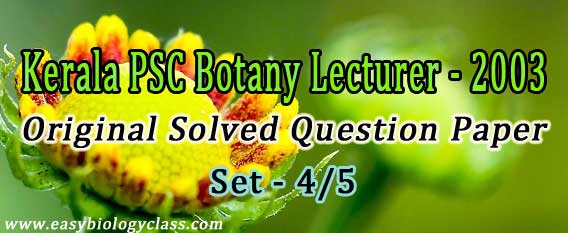
Kerala PSC Botany Lecturer / Assistant Professor Original Solved Question Paper: 2003 Exam
(Question Paper Code: 250/2003)
Original solved question paper of Kerala PSC Botany Lecturer/Assistant Professor examination conducted by Kerala PSC (Kerala Public Service Commission) for the recruitment / appointment of Botany Lecturer/Assistant Professor in Government Colleges of Kerala under the Directorate of Collegiate Education, Trivandrum, Kerala. The test was conducted in the year 2003 and the Question Paper Code Number is 250/2003. All questions were in MCQ (Multiple Choice Questions) format. A detailed answer key with explanations is given at end of each set.
Part – 4/5 (Questions 61 – 80)
61. Regma is the fruit type in:
a. Orange
b. Anacardium
c. Ricinus
d. Paddy
62. Technology for producing a new protein from a modified gene by recombinant DNA is called:
a. Protein engineering
b. Gene cloning
c. Metabolic engineering
d. Gene therapy
63. Cylindrical towers of grass or silage can be stored for a long during without desiccation due to:
a. Loss of moisture which prevent the action of microbes
b. Increased temperature develop inside prevents bacterial action
c. Anaerobic condition developed inside prevents fermentation of carbohydrate
d. Bacterial fermentation converts carbohydrate to lactic acid that prevent decay
64. Cerenkov radiation is:
a. A high speed radiation of charged particles
b. An electromagnetic radiation with high energy
c. A low energy radiation produced by light retardation
d. A group of high energy radiation that cannot pass through atmosphere
65. A famous Indian bryologist:
a. P. Maheswari
b. S.R. Kashyap
c. Biral Sahni
d. J.C. Bose
66. Pond and lake filled with decaying organic matter emit gases and have no biological activity. This condition is:
a. Pollution
b. Sedimentation
c. Eutrophication
d. Succession
67. Absorption spectrum is specific for a substance because:
a. Equal quantity of energy is absorbed that of electrons
b. Energy absorbed by the atom is higher than its energy
c. Energy absorbed is lower than that of electron carrier
d. Absorbed energy of specific radiation is enough to shift the electron to higher level
68. Mycelial, filamentous, branched and gram positive prokaryotes:
a. Actinomycetes
b. Phycouycetes
c. Ascomycetes
d. Basidiomycetes
69. Chantrantia stage is:
a. Juvenile stage of bryophyte
b. Developing stage of Cycas seed
c. Juvenile stage of red algae
d. Germinating filament of fungi
70. ‘Smut’ is the dark powdery mass of spores formed in sori of leaves. These spores are:
a. Teleutospores
b. Aeciospores
c. Teliospres
d. Acdiospores
71. Gel permeation is the technique used for:
a. Pigment separation
b. Protein purification
c. pH determination
d. Separation of inorganic chemicals
72. Philodendron cordatum is:
a. A bushy flowering plant
b. A beautifully flowering forest tree
c. A bushy flowering forest plant
d. An indoor climbing plant
73. Range of same phenotypic expression by several alleles:
a. Isoallele
b. Multiple allele
c. Alloallele
d. Mutant allele
74. Split genes are:
a. Discontinuous sequences of DNA which are not represented in mRNA
b. Continuous sequences of DNA that can synthesis of two protein chain
c. Overlapping sequences to produce more polypeptides
d. Genes which split during protein synthesis
75. Chromosome jerking movements are affected by a protein known as:
a. Dynein protein
b. Histone protein
c. Nucleic protein
d. Cyclin protein
76. Club shaped asexual spores in Aspergillus niger is:
a. Sporoconidia
b. Phialoconidia
c. Secondary conidia
d. Asco conidia
77. Finger like intracellular mycelial branches in VA mycorrhiza is:
a. Rhizoidal hyphae
b. Mycelial strands
c. Mycelial cord
d. Arbuscules
78. Thigmotropism is:
a. The reaction of plants to chemical stimuli
b. The reaction of plants to atmospheric conditions
c. The reaction of plants to stimulus of touch
d. The reaction of plants to gravity and temperature
79. Smoke treatment for simultaneous and rapid ripening in banana is due to the action of:
a. Auxins
b. Giberellins
c. Ethylene
d. Enzyme stimulation
80. Which of the following is not a feature of selfish gene?
a. Self-replicating
b. Favour natural selection
c. Favour male sterility
d. Independent expression
Kerala PSC Botany Lecture Exam 2003 Question Paper
| Part – 1/5 | Part – 2/5 | Part – 3/5 | Part – 4/5 | Part – 5/5 |
Answer Key (Kerala PSC Botany Lecturer Exam 2003) Part 3/5
The answer key is prepared with best of my knowledge and all of them may not be correct. If you find any mistakes in my decision, you should point it out and it will be appreciated. Contact: Admin.
61. Ans. (c). Ricinus
62. Ans. (a). Protein engineering
63. Ans. (d). Bacterial fermentation converts carbohydrates to lactic acid that prevents bacterial decay
64. Ans. (b). An electromagnetic radiation with high energy
65. Ans. (b). S.R. Kashyap
66. Ans. (a). Pollution
67. Ans. (d). Absorbed energy of specific radiation is enough to shift the electron to higher level
68. Ans. (a). Actinomycetes
69. Ans. (c). Juvenile stage of red algae
70. Ans. (a). Teleutospores
71. Ans. (b). Protein purification
72. Ans. (d). An indoor climbing plant
73. Ans. (a). Isoallele
74. Ans. (a). Discontinuous sequences of DNA which are not represented in mRNA
75. I do not know the answer, if you know the answer, please inform me.
76. Ans. (b). Phialoconidia
77. Ans. (d). Arbuscules
78. Ans. (c). The reaction of plants to stimulus of touch
79. Ans. (c). Ethylene
80. I do not know the answer, if you know the answer, please inform me.